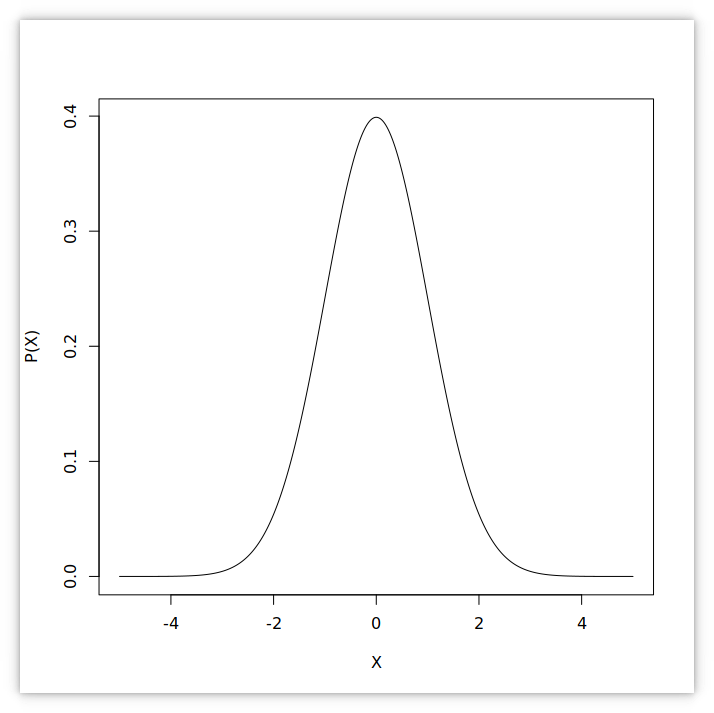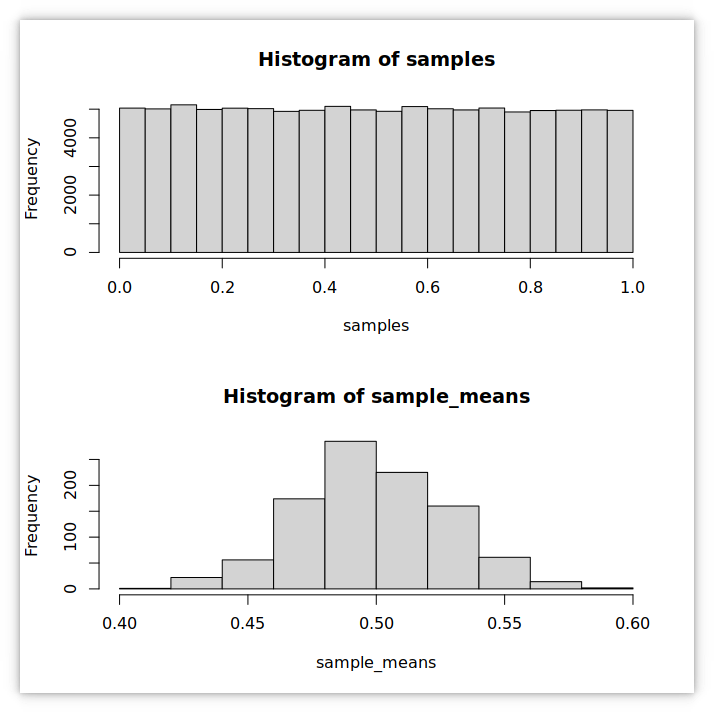Statistics and probability review
- 1 Uncertainty
- 2 Inductive vs. deductive reasoning
- 3 Statistics vs. probability
- 4 What is the probability of a coin landing on heads?
- 5 Dice questions
- 6 Bayes’ theorem
- 7 Major areas of statistics
- 8 Probability distribution
- 9 Important statistics
- 10 Normal distribution
- 11 Central limit theorem
- 12 Hypothesis testing
- 13 Homework: Problem 5.1 (Chin 2000)
- 14 Reading materials
1 Uncertainty
We have to embrace uncertainty when studying science because we only have limited knowledge.
The lack of certainty or confidence is called uncertainty.
In engineering, we incorporate uncertainty into the safety factor.
1.1 Epistemic vs. aleatory uncertainty
Epistemic uncertainty arises because of the lack of our knowledge.
Aleatory uncertainty arises because of randomness.
2 Inductive vs. deductive reasoning
Inductive reasoning starts with observations and analyzes data to formulate a theory.
Deductive reasoning starts with ideas or premises and observes data to make a conclusion.
3 Statistics vs. probability
Statistics involves the frequency analysis of past events and “enables us to measure the extent to which our world is ideal” (Skiena 2001).
Probability deals with the likelihood of future events and “enables us to find the consequences of a given ideal world” (Skiena 2001).
4 What is the probability of a coin landing on heads?
Do you know this probability in advance without any experiments?
Do you have to throw a coin a lot of times to observe what happens?
5 Dice questions
- What is the probability of a die rolling a 1?
- What about a 1 and then a 6 in a sequence?
- A 1 and a 6 from two dice simultaneously?
6 Bayes’ theorem
\[P(A|B) = \frac{P(A\cap B)}{P(B)} = \frac{P(B|A)P(A)}{P(B)}\]
6.1 Failing in math and/or hydrology
Probability of failing in math: $P(M)=0.3$
Probability of failing in hydrology: $P(H)=0.2$
Are these two events related or independent?
Probability of failing in both math and hydrology: $P(M\cap H)=0.1$
What is the probability of failing in either math or hydrology $P(M\cup H)$?
What is the probability of failing in hydrology when you learned that you failed in math $P(H|M)$?
7 Major areas of statistics
Descriptive statistics is used to describe data. Examples?
- Mean $\mu=\frac{\sum_{i=1}^n x_i}{n}$
- Variance $\sigma^2=\frac{\sum_{i=1}^n(x_i-\mu)^2}{n}$
Inferential statistics is used to make predictions. Examples?
- Hypothesis testing
- Regression analysis
8 Probability distribution
A probability distribution represents the frequency or probability of occurrence of different values of a random variable.
A random variable is described by its probability distribution.
8.1 Discrete probability distribution
$X$ is a random variable, $x_i$ is a value of $X$, and $g(X)$ is an arbitrary function of $X$. $\def\expected#1{\operatorname{E}\left[#1\right]}$
\[ f(x_i)\geq 0\qquad\forall x_i \] \[ \sum_{i=1}^n f(x_i)=1 \] \[ F(x_i)=P(x_j\leq x_i)=\sum_{x_j\leq x_i}f(x_j) \] \[ \expected{g(X)}=\sum_{i=1}^n g(x_i) f(x_i) \]
$f(x_i)$ is the probability distribution function (PDF) and $F(x_i)$ is the cumulative distribution function (CDF). $\expected{g(X)}$ is the expected value of $g(X)$.
8.2 Continuous probability distribution
\[ f(x)\geq 0\qquad\forall x \] \[ \int_{-\infty}^{+\infty}f(x)\,dx=1 \] \[ F(x)=P(x’\leq x)=\int_{-\infty}^x f(x’)\,dx’ \] \[ \expected{g(X)}=\int_{-\infty}^{+\infty}g(x) f(x)\,dx \]
9 Important statistics
$\mu_x$: Arithmetic average or mean of $X$ if $g(x)=x$; measure of the average
$\sigma_x^2$: Variance of $X$ if $g(x)=(x-\mu_x)^2$; measure of the variability about the average
$g_x$: Skewness of $X$ if $g(x)=\frac{(x-\mu_x)^3}{\sigma_x^3}$; measure of the symmetry about the average
9.1 Example 5.1 (Chin 2000)
A water-resource system if designed such that the probability, $f(x_i)$, that the system capacity is exceeded $x_i$ times during the 50-year design life is given by the discrete probability distribution in the table. What is the mean number of system failures expected in 50 years? What is the variance and skewness of the number of failures?
- $\mu_x=2$
- $\sigma_x^2=1.92$
- $g_x=0.631$
| $x_i$ | $f(x_i)$ |
|---|---|
| 0 | 0.13 |
| 1 | 0.27 |
| 2 | 0.28 |
| 3 | 0.18 |
| 4 | 0.09 |
| 5 | 0.03 |
| 6 | 0.02 |
| >6 | 0.00 |
9.2 Homework: Example 5.2 (Chin 2000)
The probability density function, $f(t)$, of the time between storms during the summer in Miami is estimated as \[ f(t)=\begin{cases} 0.014 e^{-0.014t}& t>0\\ 0& \text{otherwise} \end{cases} \] where $t$ is the time interval between storms in hours. Estimate the mean, standard deviation, and skewness of $t$.
Use these facts: \[ \int_0^\infty e^{-ax}\,dx=\frac{1}{a},\qquad \int_0^\infty x e^{-ax}\,dx=\frac{1}{a^2},\qquad \int_0^\infty x^2 e^{-ax}\,dx=\frac{2}{a^3},\qquad \int_0^\infty x^3 e^{-ax}\,dx=\frac{6}{a^4} \]
- $\mu_t=71 \text{h}$
- $\sigma_t=71 \text{h}$
- $g_t=2.1$
10 Normal distribution
Statisticians and probabilists love normal distributions thanks to the central limit theorem.
\[f(x)=\frac{1}{\sigma\sqrt{2\pi}}e^{-\frac{1}{2}\left(\frac{x-\mu}{\sigma}\right)^2}\] where
- $x$ is a random variable,
- $\mu$ is the mean or expected value of $x$, and
- $\sigma$ is the standard deviation.
Standard normal distribution when $\mu=0$ and $\sigma=1$.
11 Central limit theorem
# R code by Huidae Cho
samples <- c()
sample_means <- c()
for(i in 1:1000){
sample <- runif(100) # take 100 random values from a uniform distribution
samples <- c(samples, sample) # collect samples
sample_means <- c(sample_means, mean(sample)) # collect sample means
}
par(mfcol=c(2,1))
hist(samples) # plot the histogram of samples
hist(sample_means) # plot the histogram of sample means12 Hypothesis testing
Hypothesis testing is a quantitative inferential statistical method to see whether your data statistically supports a certain hypothesis.
12.1 Null hypothesis
A default position that there is no significant relationship between two phenomena or among groups.
Often, denoted by $H_0$.
We never accept the null hypothesis. We only reject or fail to reject it given the level of confidence ($\alpha$-level).
12.2 Alternative hypothesis
A hypothesis that there is significant relationship between two phenomena or among groups.
Denoted by $H_a$.
12.3 What is the $\alpha$-level?
The $\alpha$-level or significance level indicates how extreme observed data must be before we can reject the null hypothesis.
12.4 A $p$-value?
The $p$-value is the probability that we observe a certain phenomenon under the null hypothesis.
12.5 Testing hypotheses
If the $p$-value is less than or equal to the $\alpha$-level, our data is unusual—more extreme than the significance level—and we reject the null hypothesis. We can say the data is statistically significant with a significance level of $\alpha$. In this case, the alternative hypothesis is supported, not accepted.
If the $p$-value is greater than the $\alpha$-level, the data is usual—not as extreme as the significance level—and we fail to reject the null hypothesis. We can say the data is statistically non-significant with a significance level of $\alpha$.
12.6 Exercises
12.7 Chi-squared test
A $\chi^2$ test is a statistical method to test if data follows a certain probability distribution.
If $N$ observations are divided into $M$ classes and $X_m$ indicates the number of observations in class $m$, the following random variable \[ \chi^2=\sum_{m=1}^M\frac{(X_m-Np_m)^2}{Np_m} \] follows a chi-square distribution where $p_m$ is the theoretical probability of an observation in class $m$.
The number of degrees of freedom is $M-1-n$ where $n$ is the number of population parameters estimated using sample statistics.
We fail to reject the null hypothesis that samples are drawn from a certain probability distribution if $0\leq\chi^2\leq\chi_\alpha^2$.
12.8 Example 5.16 (Chin 2000)
Analysis of a 47-year record of annual rainfall indicates the following frequency distribution:
| Range (mm) | Number of outcomes | Range (mm) | Number of outcomes |
|---|---|---|---|
| <1,000 | 2 | 1,250–1,300 | 7 |
| 1,000–1,050 | 3 | 1,300–1,350 | 5 |
| 1,050–1,100 | 4 | 1,350–1,400 | 3 |
| 1,100–1,150 | 5 | 1,400–1,450 | 2 |
| 1,150–1,200 | 6 | 1,450–1,500 | 2 |
| 1,200–1,250 | 7 | >1,500 | 1 |
The measured data also indicate a mean of 1,225 mm and a standard deviation of 151 mm. Using a 5% significance level, assess the hypothesis that the annual rainfall is drawn from a normal distribution.
Use these tables:
13 Homework: Problem 5.1 (Chin 2000)
A flood-control system is designed such that the probability that the system capacity is exceeded $X$ times in 30 years is given by the discrete probability distribution in the table.
What is the mean number of system failures expected in 30 years? What is the variance and skewness of the number of failures?
| $x_i$ | $f(x_i)$ |
|---|---|
| 0 | 0.04 |
| 1 | 0.14 |
| 2 | 0.23 |
| 3 | 0.24 |
| 4 | 0.18 |
| 5 | 0.10 |
| 6 | 0.05 |
| 7 | 0.02 |
| 8 | 0.01 |
| >9 | 0.00 |
14 Reading materials
- Probability
- Probability versus Statistics
- Probability vs Statistics
- What’s the difference between probability and statistics?
- The Difference Between Deductive and Inductive Reasoning
- Deductive Reasoning vs. Inductive Reasoning
- Can you say that statistics and probability is like induction and deduction?
- Bayes’ theorem
- Statistical concepts in environmental science
- Descriptive statistics
- Statistical inference
- Normal distribution
- Central limit theorem
- Standard Deviation and Variance

